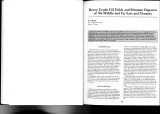TO
| Title | Date | Subject | Description | ||
|---|---|---|---|---|---|
| 26 |
 |
Field experiment of in-situ oil recovery from a Utah tar sand by reverse combustion | 1976 | in-situ oil recovery; Utah tar sand; reverse combustion; oil recovery | Part of the mission of the Energy Research and Development Administration (ERDA) is to develop all energy sources to meet the needs of present and future generations. Toward that mission the Laramie Energy Research Center (LERC) is conducting research and field experiments for the development of rec... |
| 27 |
 |
Field guide to lacustrine and related nonmarine depositional environments in tertiary rocks, Uinta Basin, Utah | 1976-11 | lacustrine environments; nonmarine depositional environments; tertiary rocks | The lower part of the Tertiary System in the Uinta Basin of northeastern Utah and northwestern Colorado (fig. 1) reflects a series of very complex and variable forms of continental sedimentation in a basin of internal drainage. These complex forms represent the disruption of the Cretaceous depositio... |
| 28 |
 |
Fine particle emissions from residual fuel oil combustion: Characterization and mechanisms of formation | 2000 | fine particle emissions; residual fuel oil combustion; airborne fine particulate matter (PM); particulate characteristics of PM | The characteristics of particulate matter (PM) emitted from residual fuel oil combustion in two types of combustion equipment were compared. A small commercial 732 kW rated fire-tube boiler yielded a weakly bimodal particulate size distribution (PSD) with over 99% of the mass contained in a broad co... |
| 29 |
 |
Formation pathways of ethynyl-substituted and cyclopenta-fused polycyclic aromatic hydrocarbons | 2000 | formation pathways of aromatic hydrocarbons; aromatic hydrocarbons; ethynyl-substituted aromatic hydrocarbons; cyclopenta-fused polycyclic aromatic hydrocarbons; PAH; ethynyl-PAH | Two novel classes of polycyclic aromatic hydrocarbons (PAH), those with ethynyl substituents (ethynyl- PAH) and those with externally fused five-membered rings (cyclopenta-fused PAH or CP-PAH), have recently been identified in the products of a variety of fuels and combustion/pyrolysis environments.... |
| 30 |
 |
FT-IR and 1H NMR characterization of the products of an ethylene inverse diffusion flame | 2006 | ethylene inverse diffusion flame products; analysis of the chemical functional groups; FT-IR and 1H NMR | Knowledge of the chemical structure of young soot and its precursors is very useful in the understanding of the paths leading to soot particle inception. This paper presents analyses of the chemical functional groups, based on FT-IR and 1H NMR spectroscopy of the products obtained in an ethylene inv... |
| 31 |
 |
Geological assessment of heavy-oil reservoirs in the Lloydminster area, using a computerized data base | 1987 | heavy-oil reservoirs; geological assessment; heavy-oil reservoirs; wells | Heavy-oil reservoirs of the Lower Cretaceous Mannville Group in the Lloydminster area (Western Canada) occur in a sequence of complexly arranged sandstones, siltstones, shales, and coals. Trapping mechanisms vary, and the precise geological controls governing hydrocarbon accumulations are not well u... |
| 32 |
 |
Geology and genesis of the coast range province of California and its hydrocarbon deposits | 1987 | hydrocarbon deposits; tar sand; oil shale | California is along the western borderland of North America where sedimentary deposits accumulated along the eastern Pacific margin. During that time, subduction diastrophism prevailed in the late Mesozoic-early Cenozoic era, and right-lateral strike-slip shear diastrophism prevailed in the middle a... |
| 33 |
 |
Geology and geochemistry of Santa Rosa tar sands | 1987-11-02 | Santa Rosa tar sands; tar sands; heavy oil deposits; Triassic Santa Rosa Sandstone | Heavy oil deposits 11 km (7 mi) north of the town of Santa Rosa, Guadalupe County, New Mexico, in the Triassic Santa Rosa Sandstone, were mined during the 1930s. Renewed interest in this deposit in the late 1970s so far has not resulted in exploitation because of unfavorable economics and the encroa... |
| 34 |
 |
Geology of heavy crude oil and natural bitumen in the USSR, Mongolia, and China | 1987 | geology; heavy crude oil; natural bitumen; USSR, Mongolia, China; heavy oil resources; natural bitumen resources | The USSR, Mongolia, and China occupy an area of 33,385,390 km2, or a quarter of the earth's land area. Large reserves and resources of heavy crude oil and natural bitumen are present, especially on the Eastern European (Russian) and Siberian platforms, where at least 700 billion bbl is present (out ... |
| 35 |
 |
Geology of the Mill Fork Area, Utah | 1972-12 | geology; Mill Fork area; geologic structure; Green River formation | The Mill Fork area comprises about 70 square miles of Cretaceous ( ? ) and Tertiary sediments at the northern end of the Wasatch Plateau in Utah County, Utah. Over 9000 feet of nonmarine sediments are present and belong to the North Horn, Flagstaff, and Green River formations. These sediments record... |
| 36 |
 |
Getting from here to there: Devising an optimal regulatory model for CO2 transport in a new carbon capture and sequestration industry | 2010 | regulatory model for CO2 transport; new carbon capture and sequestration; CCS; regulatory model | If CCS is to become a broad-scale commercial industry in time to meet the need for climate change mitigation, the United States must adopt a regulatory model that will allow for efficient construction of critical infrastructure. A well-crafted regulatory framework gives private would-be CCS operator... |
| 37 |
 |
Green River Formation at Raven Ridge, Uintah County, Utah | 1965-07 | Green River formation; Raven Ridge; sandstone beds; shale; limestone; marlstone; oil-bearing strata | Along Raven Ridge in Uintah County, Utah, exposures of the Green River Formation contain a complex sequence of intertonguing beds of sandstone, shale, limestone, and marlstone. These strata are considered to represent deposition in an orderly sequence of environments from the flood plain through the... |
| 38 |
 |
Heavy crude oil fields and bitumen deposits of the Middle and Far East and Oceania | 1987 | heavy crude oil fields; bitumen deposits; Middle and Far East and Oceania; oil resource | A total of 119 heavy-oil fields are located in the Middle and Far East and Oceania, in 19 countries. Of these, 12 have ultimate recoveries of more than 500 million barrels, and nine of more than 1000 million barrels. About 97% of the total resource of 120,000 million barrels is found in the Middle E... |
| 39 |
 |
Heavy oil production operations in Potiguar Basin, Brazil | 1987 | heavy oil production operations; heavy oil; Portiguar Basin; oil fields; oil | The Potiguar basin is located on the northeastern Brazilian coast and comprises an onshore portion with 21,500 km2 (8300 mi2) and its offshore extension (Fig. 1). In the last 4 years, many oil fields have been discovered in the onshore portion, where today's production reaches 20,000 bbl/d. The oil ... |
| 40 |
 |
Heavy-oil and bitumen projects in Madagascar | 1987 | heavy oil; bitumen; Madagascar; Bemolanga tar sand; Tsimiroro heavy crude oil; mining and bitumen-separation operation | Madagascar contains two important deposits, the Bemolanga tar sand and the Tsimiroro heavy crude oil. Although known for years, they have received intensive investigation recently in effort to achieve a measure of energy independence in the face of rising oil costs and dollar-exchange values. The ai... |
| 41 |
 |
Heavy-oil deposit, Great Salt Lake, Utah | 1987 | heavy-oil deposit; Great Salt Lake; Neogene basins | The western portion of the Great Salt Lake contains two large Neogene basins, informally called the "North" and "South" basins. These basins are separated by an arch that trends northeast between Carrington Island and Fremont Island. Both basins are filled with Miocene, Pliocene, and Quaternary sedi... |
| 42 |
 |
High-temperature interactions between multiple-metals and kaolinite | 2002 | high-temperature interactions; multiple-metals; kaolinite | High-temperature combustion flue gases provided the environments for this investigation of multiple-metals interactions with dispersed kaolinite. Whereas previous research was restricted to interactions of single-metals with kaolinite powders, this work focuses on understanding how kaolinite transfo... |
| 43 |
 |
Immigrants transform Utah: entering a new era of diversity | 2004-05 | Utah is generally perceived as an extremely homogeneous state whose population can trace its ancestry mostly to northern Europe. Listings for surnames like Hansen, Jensen, and Christensen do fill many pages in local telephone directories throughout the state. According to census counts, the minority... | |
| 44 |
 |
Importance of bitumen viscosity in the hot water processing of domestic tar sands | 1983 | bitumen viscosity; hot water processing; domestic tar sands; bitumen recovery | The separation efficiency of the hot water digestionflotation technique used for bitumen recovery from various domestic tar sands was evaluated. Bitumen viscosity was found to be the most important tar sand property in determining the success of the bitumen separation. Bitumen viscosity of the tar s... |
| 45 |
 |
In-furnace capture of cadmium and other semi-volatile metals by sorbents | 2005 | in-furnace capture; cadmium capture; semi-volatile metals; sorbents; sorbent utilization | An 18 kW, cylindrical (inside diameter = 15-cm), 6-m high, laminar, downflow furnace was used to investigate the mechanisms governing reactive scavenging of cadmium vapors from combustion environments, by hydrated lime and kaolinite powder sorbents. Two major physical mechanisms dominate the reactio... |
| 46 |
 |
Influence of biodegradation on the chemical composition of heavy oil and bitumen | 1987 | biodegredation; chemical composition of heavy oil and bitumen; heavy oil; bitumen; biodegredation of petroleum | Biodegradation of petroleum is a selective metabolism of special organic compounds by an ensemble of microorganisms. It apparently starts under aerobic conditions, which are provided in areas invaded by surfacederived, oxygen-rich formation waters. Bacteria introduced into an oil pool with meteoric ... |
| 47 |
 |
Influence of the geological and geochemical characteristics of heavy oils on their recovery | 1987 | oil buoyancy; heavy oils; Likouala oil field; Emeraude oil field; water washing; oil saturation; biodegradation | The migration of an oil into a trap is governed by its buoyancy, the capillary pressure, and the hydrodynamic forces. For heavy oils the buoyancy is low; therefore, they can only saturate high-permeability zones, which are also preferentially swept by steam in a steam-drive recovery operation. Howev... |
| 48 |
 |
Investigation of coal char-slag transition during oxidation: Effect of temperature and residual carbon | 2009 | coal char; molten slag; bitumous coal; energy and fuels | The transition of coal char to molten slag at high conversion was studied for a bituminous coal using a laminar entrained-flow reactor under oxidizing conditions. Post-oxidized char particles were analyzed by various techniques including loss-on-ignition, gas adsorption analysis and scanning electro... |
| 49 |
 |
Light-oils transformation to heavy oils and asphalts-assessment of the amounts of hydrocarbons removed and the hydrological-geological control of the process | 1987 | light-oils; heavy oils; asphalts; assessment; hydrocarbons; petroleum resources; oil alteration | Heavy oils frequently represent a residue left after removal of saturated and aromatic hydrocarbons by various alteration processes. They are characterized by a high content of asphaltenes and polar compounds and by higher sulfur content than the light oils from which they were derived. In the Dead ... |
| 50 |
 |
Major tar sand and heavy oil deposits of the United States | 1985-07 | major tar sand; heavy oil deposits; heavy oil resources; tar sand resources; United States | This paper presents a current assessment of U.S. tar sand and heavy oil resources. It is based on an independent appraisal of all tar sand deposits with 100 million barrels in place or more and the construction of a heavy oil reservoir and data base of fields containing more than 20 million barrels ... |
